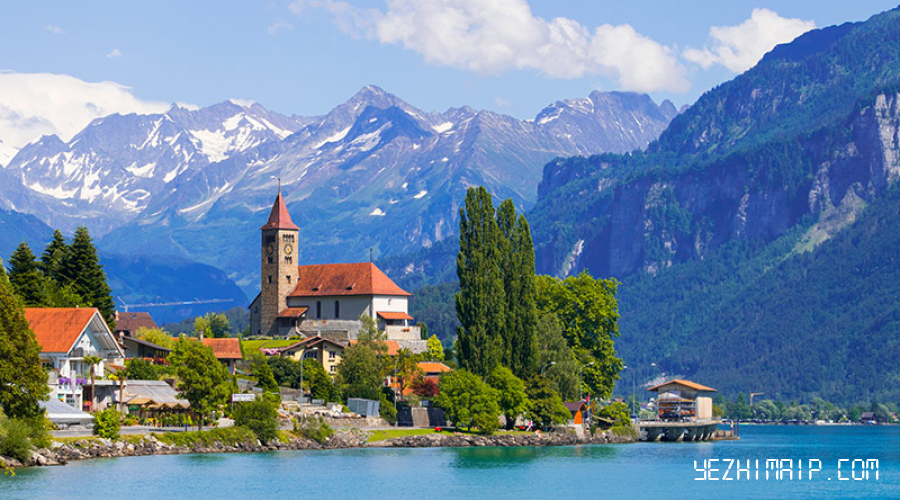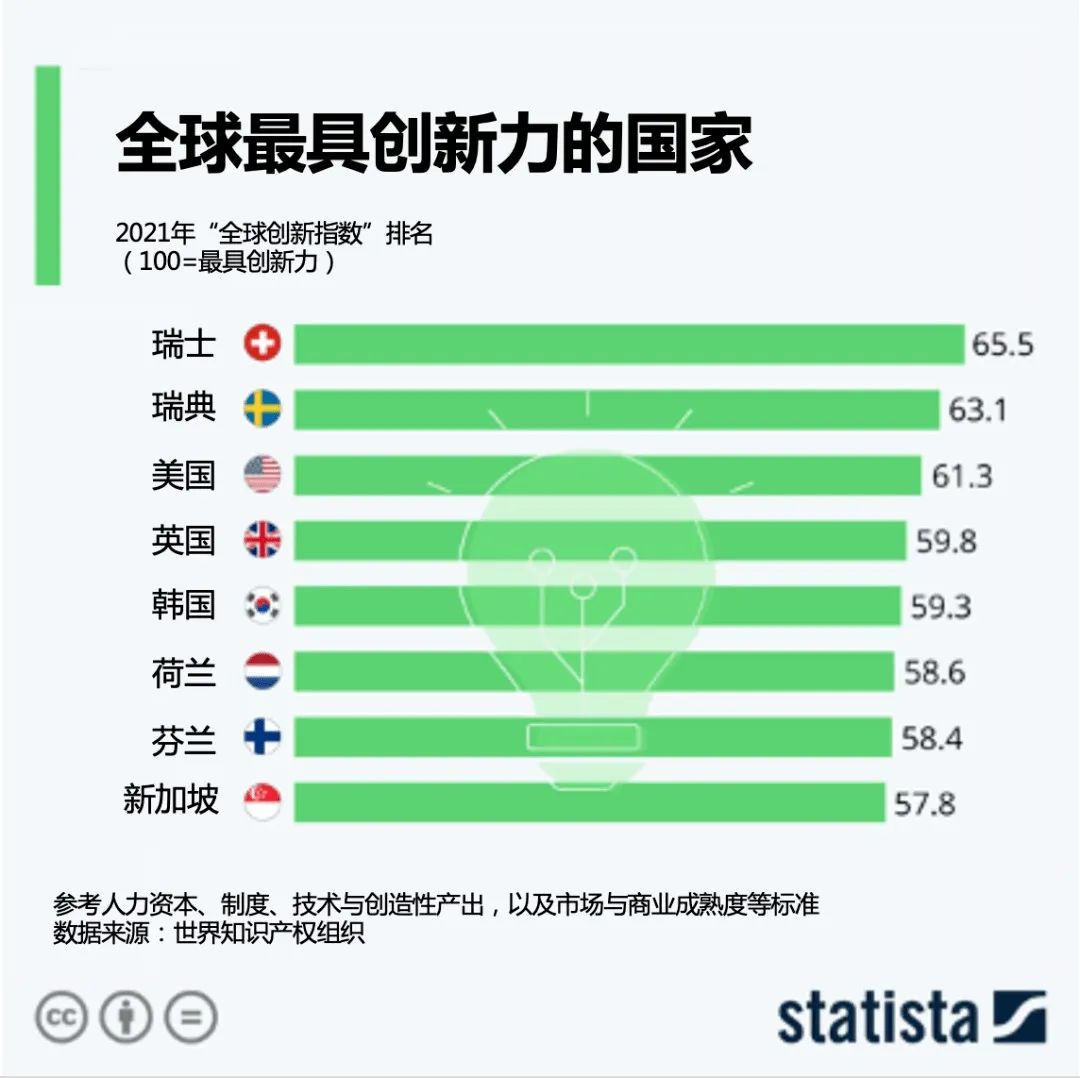
The permanent neutral country continues to lead the way in innovation
According to the 2022 Global Innovation Index Report released by the World Intellectual Property Organization, R&D and investment in global innovation activities will continue to flourish in 2021. The R&D expenditure of the world's top companies will reach more than 900 billion U.S. dollars, an increase of nearly 10% over the previous year; venture capital transactions That surged 46%, matching the record levels seen during the dot-com boom of the late 1990s. Among them, Switzerland once again topped the global innovation index, leading the innovation ranking for 11 consecutive years.

As the "Heart of Europe", Switzerland is located in the middle of Europe, bordering Germany in the north, Austria and Liechtenstein in the east, Italy in the south, and France in the west. The country with the highest rate of Nobel Prize holders. Statistics show that although the total population of Switzerland is only about 8 million, at least 25 Nobel Prize winners have been Swiss citizens since 1901. Among the Nobel Prize winners in all fields, 113 are related to Switzerland. associated.
Switzerland's super high innovation index benefits from a stable political environment, strong economic strength and a complete education system. Since it was officially recognized by the international community as a permanent neutral country at the Vienna Conference in 1815, Switzerland has never been involved in an international war. This has laid an important foundation for Switzerland's long-term stable economic development and has also won the favor of many international organizations. The United Nations Office in Europe "Palace of Nations" is the most famous. Switzerland's GDP per capita in 2021 will be US$93,720, ranking third in the world after Luxembourg and Ireland. Although Switzerland lacks mineral resources and relies on imports for 95% of the required raw materials and energy, it is a solid industrial power, especially in machinery manufacturing and medical technology, which has almost reached the world's leading level. Representative companies include ABB Group, Novartis and Nestlé. In addition to political and economic foundations, education is also one of the sources of innovation in Switzerland. Education expenditures in Switzerland account for a large proportion of the budgets of governments at all levels. It accounts for about 8% of the federal government budget, and the annual education funds of the states account for 24% of the state's total expenditure. The abundant research funds provide a strong guarantee for the scientific research of various universities and make important contributions to the improvement of Switzerland's innovation capabilities. .
In 2021, according to data from the European Patent Office (EPO), Switzerland filed a total of 8,442 patent applications, a year-on-year increase of 3.9%, higher than the European average growth rate of 2.8%. The number of patent applications per capita is 969, far ahead of the second place Sweden (488), ranking first.
Introduction to the Swiss patent system
1. Filing Language
German/French/Italian
2. Protection type
Invention patents, design patents
3. Paths for Chinese applicants to apply for patents in Switzerland
Paris Convention, PCT International Application Entry into Switzerland, Direct Application
4. Review unit
The Swiss Federal Institute of Intellectual Property examines, grants and administers Swiss industrial property rights (patents, trademarks and designs); cooperates with government agencies, associations and businesses to enforce Swiss and international IP rights. designations of origin; monitor collective rights management organizations; and provide information on intellectual property to individuals and businesses in various ways.
5. Submit your application
1) Deadline requirements:
- via Paris Convention inventions: within 12 months from the earliest priority date (priority can be restored, the request for restoration must be made within two months from the date on which the reasons for non-compliance with the time limit have been removed, or within 6 months from the date of expiry of the applicable time limit Inside)
- via Nationalization of PCT inventions: within 30 months from the earliest priority date (non-recoverable)
- Designs: within 6 months from the earliest priority date
2) Submitting an application: Swiss patent applications can be submitted on paper, or by e-mail or fax, but electronic means are not applicable to declarations of biological materials.
3) The official languages for patent registration in Switzerland are German, French and Italian. When the PCT enters the Swiss national phase, it needs to be translated into one of the official languages. Once filed, it cannot be changed, and all subsequent procedures will be in this language.
6. Review process
Formal examination: After filing a patent application, IGE initiates a preliminary investigation aimed at reviewing whether the submitted documents correspond to the content of the application, and confirms that the minimum requirements for continued examination are met.
Publication: After passing the preliminary examination, the invention patent application will be published within 18 months from the priority date.
-- Substantive examination: Invention patent applications need to undergo substantive examination, but the applicant does not need to submit a separate request for substantive examination. IGE will require payment of substantive examination fees within 2-3 years from the filing date. Substantive examination only examines whether the invention and technical documents meet the legal requirements, and does not examine novelty and inventive step. Designs are subject to formality examination only.
Authorization: After passing the formality examination and substantive examination procedures, if the examiner believes that the granted conditions are met, the official will grant the patent right, and Switzerland will not charge patent granted fees and announcement fees.
Opposition: 9 months after the granted of the application is the opposition period, and anyone can raise an opposition to the invention patent.
Features of a Swiss patent
1. Swiss patents are automatically valid in Liechtenstein based on bilateral agreements;
2. Switzerland can apply for multiple designs;
3. Generally speaking, the substantive examination is carried out 3 years after the filing of the patent application, but the applicant can request accelerated substantive examination at any time.
Friendliness to Chinese applicants:
★★★★
Gold content of patent rights:
★★★
The degree of perfection of the rights protection mechanism:
★★★
联系咨询
 | Get exact prices For the country / regionE-mail: mail@yezhimaip.com |

